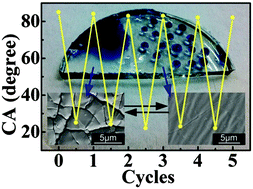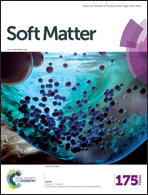Controlled wettability based on reversible micro-cracking on a shape memory polymer surface†
Abstract
Wettability modification on a polymer surface is of immense importance for flexible electronics and biomedical applications. Herein, controlled wettability of a styrene-based shape memory polymer has been realized by introducing micro-cracks on the polymer surface for the first time. The cracks were purposely prepared by thin metal film constrained deformation on the polymer. After the removal of the metallic film, wettability was dramatically enhanced by showing a remarkable reduction in the contact angle with water droplets from 85° to 25°. Subsequent systematic characterization techniques like XPS and SEM revealed that such observation could be attributed to the increased density of hydrophilic groups and the roughened surface. In addition, by controlling the temperature for annealing the treated polymer, the surface could be switched reversely to water-repellent. Therefore, this paper offers a smart tactic to manipulate the surface wettability of a shape memory polymer freely. The features of the controlled wettability surface such as high tenability, high stability and easy fabrication are promising for microfluidic switching and molecule/cell capture-release.


 Please wait while we load your content...
Please wait while we load your content...